Growing gardenias in pots requires some care and attention, but they are worth it–for their heady fragrance and beautiful appearance.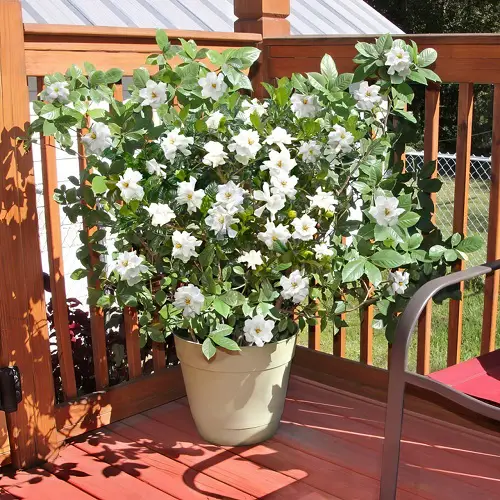
Gardenia is a subtropical shrub that originated in Asia. Its large white rose-like blooms are one of the most fragrant flowers, and together with its feathery green foliage, the gardenia plant looks magnificent. Keep reading this article to learn about Growing Gardenias in Pots!
USDA Zones: 8 – 11
Other Names: Gardenia jasminoides, cape jasmine, danh-danh, gandhraj, jasmine rose, rose jasmine
Why Grow Gardenias in Pots?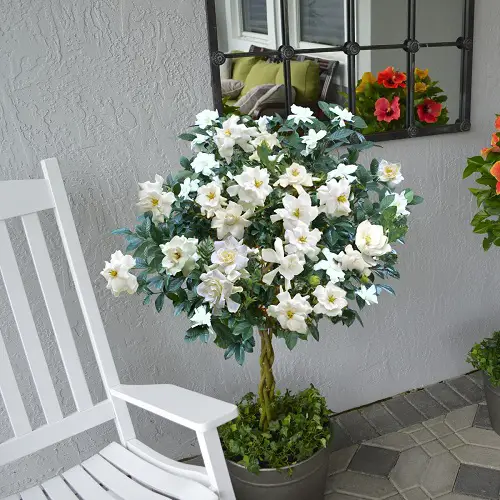
Gardenias come from warm and humid places in Asia and Africa. They like things just right–not too hot, not too cold, and definitely moist. This can be a bit tricky outdoors, especially if you don’t live in a place with constant sunshine and moderate temperatures.
That’s where growing gardenias in pots comes in. Pots give you more control over their environment. You can bring them indoors when it gets chilly or place them in a shady spot during the hottest part of the day. Plus, they look fantastic on a porch or patio.
Growing gardenias in containers is possible, especially if you’re short on space or live in a cool, temperate climate. Gardenia grows fairly easily in USDA Zones 8 to 11; below these zones, you’ll need to grow it either as a houseplant or keep it indoors in winter. But that’s easy!
Fun Fact: Gardenias can grow anywhere between 3 and 49 feet tall; isn’t that amazing?
Requirements for Growing Gardenias in Pots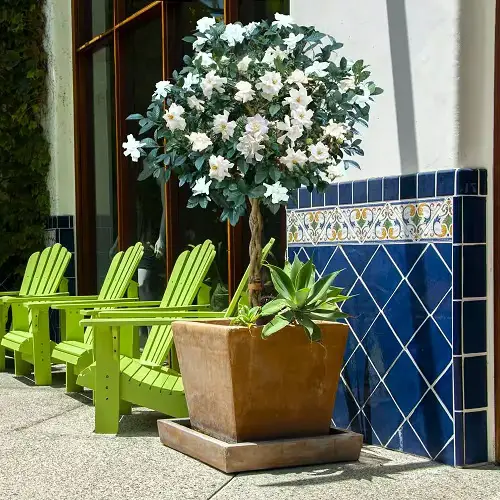
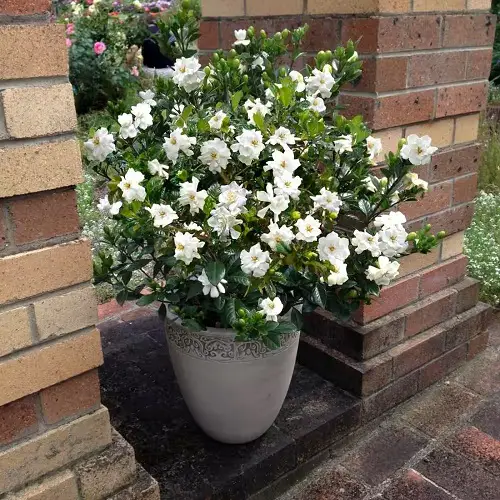
Location
Choose a location that is warm, bright, and sunny. One thing you need to care for when picking a spot for your gardenia shrub is that it needs good air circulation around it.
Maintain the airflow around it; also, be careful that you don’t place it in a place from where water will spill over its foliage every now and then, as water droplets can lead to fungal growth on leaves.
Pro tip: Choose a pot that’s only slightly bigger than your gardenia cutting’s root ball. A pot that’s 2-3 inches wider than the root ball is best. It will give the roots room to grow without wasting the potting mix and moisture in a large pot. Also, they love to stay slightly root bound and give more flowers that way so you can let them stay in the pot for some time before transplanting it to a new one.
Soil
These guys are picky eaters when it comes to dirt, preferring something light, airy, and most importantly, acidic. Regular potting mix might be a bit too heavy and not acidic enough for their taste.
- 2 parts peat moss to help retain moisture
- 1 part compost for nutrients
- 1 part perlite or coarse sand for drainage
Mixing these three parts together will create a light and well-draining mix that’s acidic, just the way gardenias like it.
Pro Tip: Believe it or not, used coffee grounds are slightly acidic and can be a great way to maintain the soil’s pH level. Just sprinkle a handful on top of the soil every few months and mix it in gently.
Water
Gardenias love consistently moist soil, but their roots drown easily in constantly soggy conditions. It’s more about checking the soil than a set schedule. Aim for watering once or twice a week, but stick your finger a few inches into the soil to see if it’s dry first.
Wilting leaves, dry and crispy leaves, and flower buds dropping are signs your gardenia is thirsty–remember that. Here’s what to do if they turn brown and start falling off.
Humidity
Ideally, they’d love a spa-like 50% to 60% humidity, but they can handle a bit less, down to around 40%.
If your home feels like a desert, especially in winter–place your potted gardenia on a pebble filled tray that is filled with water to increase the humidity level and moisture.
Temperature
Think of your gardenia like Goldilocks with temperature. It doesn’t like things too hot or too cold. Ideally, it would love sunny days around 70°F (21°C) and cozy nights around 60°F (15°C). It can survive a bit warmer, up to 55°F (30°C) but avoid scorching afternoons.
Some gardenia varieties, like the ‘August Beauty’ or ‘Chuck Hayes,’ are known for better heat tolerance than others and can also thrive in higher temperatures. But you will notice signs like reduced flowering.
Gardenia Plant Care
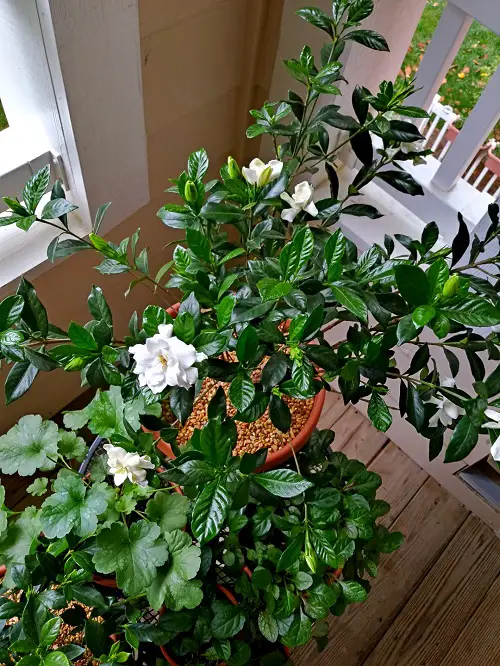
Repotting
Repot your gardenia plant every 2-3 years in late winter or early spring. While repotting, you don’t need to prune the roots as they are fine and shallow, and pruning them can cause root damage.
Fertilizer
Generally, acidic fertilizers are used for gardenia. You can find special gardenia fertilizer in any garden store or online. You can also fertilize it with azalea fertilizer.
The application of Epsom salt once a month during the growing season is also essential for the proper growth of gardenia. Acidic soil is the key to growing gardenias successfully. If your soil is not acidic, add sulfur to change the pH level.
Pro Tip: Vinegar is a weak acid, and its effects on soil pH are temporary, so you can add a spoonful of it near the plant’s base but away from the roots if you want a quick fix for the acidity. But don’t do it too much. You should use Miracid if you want to do it more often.
Pruning Gardenia
When the flowering period is over, prune your shrub slightly to maintain its beautiful, compact design. Remove all the dead, damaged, or entangled branches that are crossing each other and thwarting the penetration of sun rays and airflow.
Deadheading
Remove spent flowers as soon as they wilt and fade. This will promote the emergence of new blooms.
Overwintering
Some gardenia varieties can tolerate temperatures down to 20-15°F (-6 to -10°C), but below this temperature, it is hard to save this beautiful flowering shrub. So, if you’re growing gardenia in a pot in a cooler climate, it is better to keep the plant indoors near a south-facing window during winter and provide it warmth and temperature above 50°F (10 °C).
Pests and Diseases
Gardenias are pretty, but they can sometimes get a little under the weather from bugs and diseases. Don’t worry, though! These are mostly aphids or mealybugs. A strong water jet or special soap can send them packing.
Overwatering can also make the roots rot, so remember, thirsty but not too thirsty is the motto. With some fresh air, sunshine, and the right food, your gardenia will thrive in the pot.
A Few Additional Tips
- Don’t change the location of your gardenia again and again too often.
- A slightly root-bound gardenia plant will bloom more prolifically.
- Used coffee grounds or tea can be a good feed for your gardenia.
- Proper ventilation is important.



Thank you for this very useful info I have purchased my first gardena tree this weekend and was overwhelmed by the beautiful smell hopefully it will continue to flower :)
Should a gardenia “tree” be left in its pot since I don’t know how long its been growing in it? The tree I purchased from Sam’s Club is about 4.5′ tall in a 8″ plastic pot and lots of buds. It is in a 8″ round X 10″ high pot
I just got a second gardenia plant and don’t want it to die. The first one I received as a Mother’s Day gift from my daughter and on the 3rd week the leaves started to droop and dry out. I don’t think I overwatered it and it was placed in indirect light. How do I make sure my second plant is properly taken care of?
My 5 th one, if it dies I’m done!,,
I bought another plant and repotted it the blooms are everywhere but the buds fall off before they open what am I doing wrong
I got my gardenia tree for Mother’s Day, and had no knowledge of how to care for it. It had a lot of blooms but they kept falling off. With a closer look I discovered it had tiny ants. We sprayed and got rid of the ants, but the blooms started falling off again. We then discovered that it was full of mealybugs. Once we sprayed for them, my tree started to bloom. A week or so later though, there were more mealybugs, and we had to spray again. I probably lost 30 blooms when I first received my tree, because I didn’t examine it thoroughly! Check for bugs, if they’re present, spray for them, but keep checking for more eggs to hatch!
You mentioned adding Epson salt to the soil once during the growing season.What are the proportions? Thank you
2 TVs epsom salt to 1 gallon of water
I bought a gardenia tree and bought acid fertilizer. But I have seen some yellow leaves. I do not know if I am overwatering it but I got my finger in the soil and it was almost dry. What else can I do??????
I had the same problem, the most common cause for yellow leaves on the under-growth is over-watering or poor drainage. If the roots are sitting in water, the leaves will start turning yellow. Make sure your gardenia is not planted in a clay-based soil. I shifted my gardenia to an acidic soil mix and the results were immediate. The leaves stopped going yellow and the buds started blossoming. Also, the plant must not be put in direct sunlight.
How much Epson salt do you apply n coffee grounds
When pruning lower leaf growth, do I need to treat the pruned spot?
For buds falling off, it is also a good idea to get rid of the smaller less healthy buds so that the bigger healthier ones have a better chance of blossoming.
I have a small Gardenia Bonsai that I’ve been carrying for since July. I brought her indoors for the winter. She’s been doing fine until 2 weeks ago. Her leaves have become very limp. They are turning yellow at a rapid pace. A lot of dry brown leaves too. She’s drop leaves like crazy (most are gone now). Even her green leaves. Where did I go wrong and do I have a chance to save her? Thank you.
Hello I am really excited for our new purchase of gardenia trees. I would like to repot these in a 24″ planter very tall) and add additional plants at the base at soil. My question is should I fill the entire pot with soil or should I first add rocks on the bottom of new planter to have better drainage then add soil over rocks? Or should the new planter only have soil?
Where can I buy gardenia in a pot to grow indoor with lots of grow lights.
I have 2 gardenias in pots and the Leaves are all turned yellow. Any suggestions on what to do.
Thank you for your information. Received a gardenia tree for mother’s day gift and I want it thrive.
As mentioned in response to “what are proportions of Epsom salt to water?” What are “TV” s Thanks anyone!
Maybe you watered it with your Tap Water. Water from inside the house can contain salt, chlorine and high PH. Buy a gallon of Distilled water or collect rainwater, and use a low PH fertilizer once every 3 months while its indoors. Ferlizer should not be strong, dilute tge fertilizer or use very little of it.
Make sure you put the pot near a window where it will get at least 3 hours of sun.
Either you watered it too much with House Tap Water or watered not frequently enough and should not use the house water.
I was given a gardenia as a gift but it didn’t last long. That was a couple years ago and since then it’s been kept in a garage. If I repot it, fertilize it and pamper it, will it come back?
Beckg256@hotmail.com
Hello, I have successively grown many tropical plants, various types. Gardenias have been some of the most difficult. About 3 months ago, I bought a 3 foot Gardenia shrub, replanted it in a much larger pots with vermiculite, perlite, coffee grounds and potting soil. I fertilize about every 4 weeks. I’m in Colombia S. A. and grow the shrub on my balcony where it gets 4 – 5 hours of direct sun light per day. For the past few years, it seems there has been a lot of rain here with fewer sunny days. The plant originally had many buds but they wilted. I keep several shallow containers with water and stones below the plant to provide humidity. The plant is slightly elevated above balcony floor. I try not to move the plants position much. Any advice on growing a more healthy and productive plant?
Great information and exactly what I needed for my new plant.
Gardenias love pickle juice.